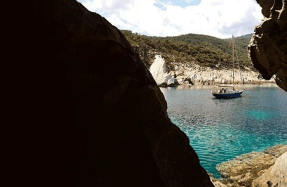

PART 1 OF 2
■ Avoiding bad weather n Preparing your boat above and below
■ Preparing your boat above and below
■ Reducing sail as the storm builds
MARTIN THOMAS was a commodore of the OCC, and is editor of the latest edition of Heavy Weather Sailing. He races and cruises his own classic yacht


From South Ocean pitchpolings to North Atlantic hurricanes, much has been written about the means and methods of surviving heavy weather in open water.
The column inches tend to be dedicated to those with nowhere to hide, but with plenty of sea room to play with. As coastal cruising sailors, we have the luxury of avoiding the worst of it, but we still sail for long enough to eventually be caught out. The proximity of shelter, relatively speaking, is a blessing at this point – we don’t have to endure the battering for very long – but the presence of land is also a hazard, reducing sea room, and with it, options. So knowing how to prepare and how to handle your boat when you do get caught, could be the difference between an entertaining anecdote at the bar later or a call to the lifeboat.
We thought it was worth drawing on the combined knowledge of the seasoned sailors who have contributed to the latest edition of Adland Coles’ bible on the subject, Heavy Weather Sailing, examining what should be done in heavy weather in coastal water, and then trying it out to see what works in practice. Editor Theo Stocker volunteered for this enviable duty, which he insists was actually great fun, and having watched the weather forecast all winter, managed to line up yachts, RIBs, crew and photographers with a Force 8 gale in order to go and play in the rough stuff.
AVOIDANCE
The best way to cope with heavy weather is to avoid it. Forecasts are so accurate these days that coastal cruising sailors, if they do not set out into deteriorating weather, will rarely be caught out. Beth Leonard, author of Blue Horizons, who has circumnavigated the globe twice, has estimated that she has experienced light or insufficient wind for about 70% of her time at sea.

Similarly, long-distance sailors Lin and Larry Pardey reported battling gale force winds or worse for 3% of the time.
On the other hand, storms are becoming more frequent and more violent and, for most of us, one storm is enough. In 2022 Hurricane Ian hit the eastern American seaboard with more energy and higher winds than any before. In the same year, Storm Eunice generated record winds






